
American Lotus has edible seeds and roots. Photo by Green Deane
Yellow ponds, that’s how I think of it, or in some places, yellow rivers. That’s because the American Lotus is in blossom. The first time I saw a small lake of these blossoms was when an old dry lake was deepened for a housing development. The next spring suddenly what was for decades a dry lake was full of American Lotus blossoms. This is because the seeds can stay viable some 400 years, or so the experts report. Talk about a survival food! There are multiple edible parts on the American Lotus but I prefer the seeds. I also think when collecting by hand the seeds proved to be the most calories for the amount of work. The roots are edible but digging them up can be a messy, laborious job. Locally American Lotus are easy to find now: Just look for a lake with large yellow blossoms on long stems. Further north and west they are a favorite sight on rivers such as the Mississippi. To read more about the American Lotus go here.
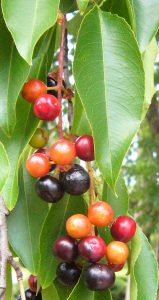
Black Cherries.
Black Cherry has been mentioned a couple of times earlier this year and that’s the reason for it being mentioned now: The season. Its fruiting season seems to be longer this year than usual. I saw trees picked free of fruit months ago but just today saw one heavy with fruit in Lake Mary. A Black Cherry was also still fruiting in Cassadaga this past weekend seen during a foraging class. It is safe to say Black Cherries look better than they taste. There is an initial cherry sweetness but then a residual bitterness takes over (whereas chokecherries are bad start to finish.) Black Cherries are much better processed into wine and jelly (or cough medicine from the bark.) Do not eat the seeds. To read more about the Black Cherry go here.

Classes are held rain or shine or cold.
Foraging Classes: We travel a bit this weekend, from a class in Orlando Saturday to Gainesville Sunday. Locally we may see some interesting mushrooms — it the start of the season — and in Gainesville I’m looking forward to seeing what Blueberries are still in season.
Saturday, June 9th, Blanchard Park, 10501 Jay Blanchard Trail, Orlando, FL 32817. 9 a.m. Meet at the pavilion east of the tennis courts near the YMCA.
Sunday, June 10th, Boulware Springs Park, 3420 SE 15th St., Gainesville, FL 32641. Meet at the picnic tables next to the pump house, 9 a.m.
Saturday, June 16th, Florida State College, south campus, 11901 Beach Blvd., Jacksonville, 32246, 9 a.m.
Sunday, June 17th, Wickham Park: 2500 Parkway Drive, Melbourne, FL. 9 a.m. Meet at the dog park.
Sunday June 24th, John Chestnut County Park: 2200 East Lake Road, Palm Harbor, FL 34685. Meet at the trail head of the Peggy Park Nature Walk, pavilion 1 parking lot. 9 a.m.
Saturday, June 30th, George LeStrange Preserve, 4911 Ralls Road, Fort Pierce, FL, 34981. 9 a.m.
Sunday July 1st is a tentative Orlando Mushroom Group mushroom hunt. Time and location to be announced.
To learn more about the classes go here.
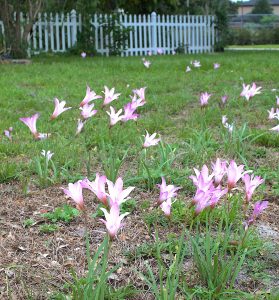
The Toxic Atamasco Lily. Photo by Green Deane
What are they? The first answer is they are NOT edible. The second is they are a threatened species. And the third answer is the toxic Atamasco lily, aka Rain Lily ( Zephranthes atamasca.) For a threatened species they are seen in a lot of lawns this time of year prompting many emails asking for an identification. These natives like wetlands but a well-watered lawn after seasonal rains will do nicely. The problem with the Atamasco is that it resembles wild garlic before it blossoms (and even has a bulb!) However, it does not have the telltale garlic aroma. Remember if it smells like a garlic AND looks like a garlic you can use it like a garlic. The Atamasco does not have any garlic aroma. It is not edible. All parts are poisonous. And while these in the picture have a pink tinge there are also all-white blossoms.
If the rainy season arrives all at once nearly everywhere then mushrooms pop up all over the state nearly everywhere. I have been picking three edible mushroom this past week.
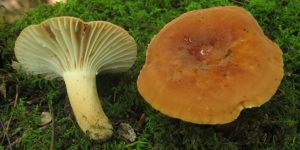
Lactifluus hygrophoroides, a “Milk Cap”
One local edible mushroom is in a trio called “Milk Caps.” When broken or scraped all three weep a liquid, often white. It is not a latex but is called that. The liquid, however, can also be light yellow or watery. That the mushroom is the weeping helps you identify the genus, sometimes the species. Common locally is the Lactifluus hygrophorides, L. corrugis, L. volemus var. volemus and L. luteolus. The latter is edible but smells strongly like a dead fish. I have picked nearly a pound of the L. hygrophorides this past week. They’re a substantial mushroom with a good flavor and texture. They are also fairly easy to identify. It has a ruddy cap, slightly felt-like to touch, wide-space gills, and bleeds a white fluid that does not stain the mushroom.
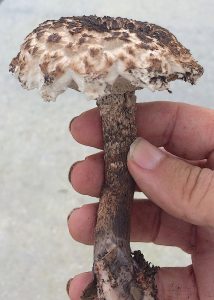
Old Man of the Woods
As distinct but in a different way is the Old Man of the Woods, Strobilomyces sp. There are a few variations — a microscope helps to sort them out — but they are all edible. They are in a group of mushrooms called Boletes. These are distinctive in that they do not have gills but rather pores on the underside. The saving grace is none of them cause lasting organ damage if you eat a toxic one. There is a short check list one can use to tell if a Bolete is a potential edible. In Europe most of the Boletes are edible, in North America most are not, and in The South if not Florida many are unidentified. Opinions vary on the Old Men. Some cook and eat the entire mushroom. Others just the cap with pores throwing away the stems, others just the cap throwing away the pores, and some not liking the texture dry the pore-less cap, powder it, and use it for flavoring.
And to be mentioned again the Chanterelles have started their seasonal flush. I have collected close to a pound of them, too. I like them sauted in real butter and then folded into an omelet.

Green Deane Forum
Want to identify a plant? Looking for a foraging reference? Do you have a UFO, an Unidentified Flowering Object you want identified? On the Green Deane Forum we chat about foraging all year. And it’s not just about warm-weather plants or just North American flora. Many nations around the world share common weeds so there’s a lot to talk about. There’s also more than weeds. The reference section has information for foraging around the world. There are also articles on food preservation, and forgotten skills from making bows to fermenting food. One special section is “From the Frightening Mail Bag” where we learn from people’s mistakes. You can join the forum by clicking on the button in the menu line.
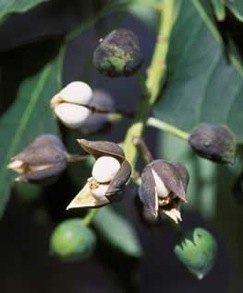 During a class recently I noticed the Chinese Tallow trees are blossoming. The tree poses a challenge. It has an edible fat and a toxic oil. The question is how to easily separate the two. And if “easily” is the wrong descriptor then how can it be made worth a forager’s while? The tree, Triadica sebifera, is an invasive species locally so finding a use for it would help the environment. Also as a source of fat it could literally be a life-saver in time of need because humans cannot survive without fat. In fact one can readily see the fat (also called wax.) It just doesn’t render easily.
During a class recently I noticed the Chinese Tallow trees are blossoming. The tree poses a challenge. It has an edible fat and a toxic oil. The question is how to easily separate the two. And if “easily” is the wrong descriptor then how can it be made worth a forager’s while? The tree, Triadica sebifera, is an invasive species locally so finding a use for it would help the environment. Also as a source of fat it could literally be a life-saver in time of need because humans cannot survive without fat. In fact one can readily see the fat (also called wax.) It just doesn’t render easily.
Each seed has a thick coating of highly saturated fat, one reason why the species is also called the popcorn tree because when in fruit it looks covered by popcorn. By all reports the outer coating is edible and has been used to make candles, hence calling it wax. In fact the tree was imported from Asia by Ben Franklin specifically to start a candle-making industry in the South. As a saturated fat the outside is very solid at room temperature. Inside the seed is a liquid oil called stillingia. It is toxic to humans.
The “wax” is supposed to melt at 104 F. I’ve tried frying the fruit. The outer coating of fat stays solid. I’ve tried boiling. No luck. My readers have tried broiling — the seeds exploded — and micowaving, they got softer but did not melt. In China they soften the fruit in boiling water than scraped them over a fine grater. Separating the fat and the oil was also a science project. Here’s what the student did. First she bought a hand-operated oil expeller. They cost about $150 on the Internet. She put the entire fruit through the press which also heats the material. Out comes a liquid mass that upon cooling has the solid saturated fat on top and the oil on bottom. She went on to make candles out of the “wax” and used the oil in a lamp which won her three science fairs and two scholarships. Way to go!
The next question we ask is whether the “wax” (saturated fat) and the oil will sufficiently separate so the fat can be used as food? Also is it just as stubborn to melt even after being processed this way? My last question would be how digestible is it? The invasive species certainly has a lot of potential. You can read more about the Chinese Tallow tree here.

Green Deane DVD Set
All of Green Deane’s videos available for free on You Tube. They do have ads on them so every time you watch a Green Deane video I get a quarter of one cent. Four views, one cent. Not exactly a large money-maker but it helps pays for this newsletter. If you want to see the videos without ads and some in slightly better quality you can order the DVD set. It is nine DVDs with 15 videos on each. Many people want their own copy of the videos or they have a slow service and its easier to order then to watch them on-line. They make a good gift for that forager you know. Individual DVDs can also be ordered. You can order them by clicking on the button on the top right of this page or you can go here.
This is weekly issue 307.
If you would like to donate to Eat The Weeds please click here. Or you can use my Go Fund Me link, or by writing to Green Deane POB 941793 Maitland FL, 32794.


I have wondered about the Chinese Tallow for many years. The wood is very soft. I would like to know if it could be used for woodenware like bowls and spoons, or is it toxic? It definitely grows like a weed here north of Houston.
Regarding: Chinese Tallow wood.
I had a large Tallow removed from my back yard and had contractor cut a section 30″ by 18″ high to be used for a chopping block. Within two years the wooden block had rotted into fist size pecs. Not much for durability.